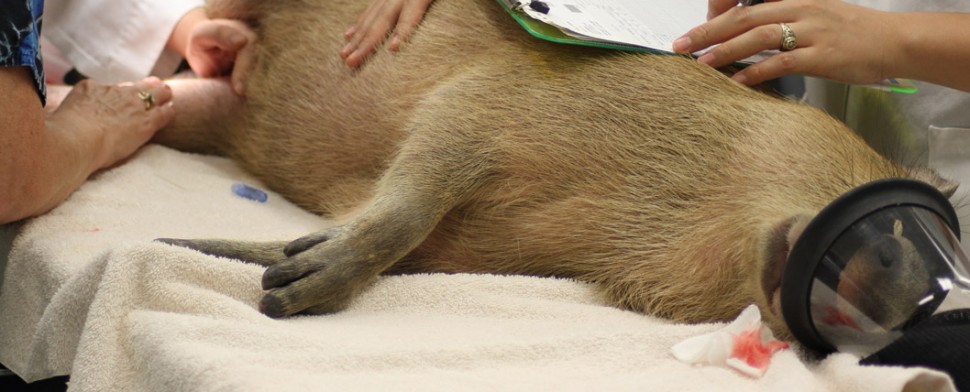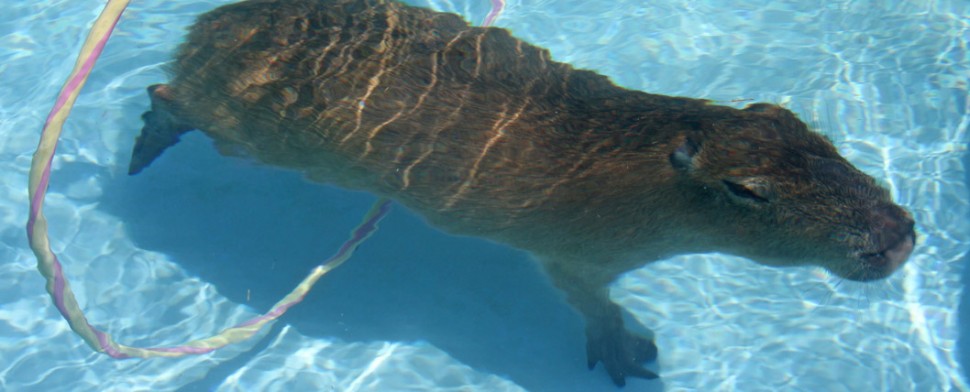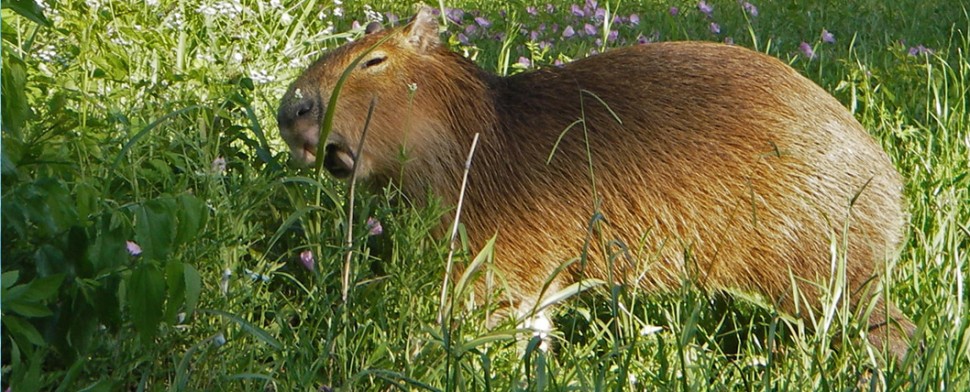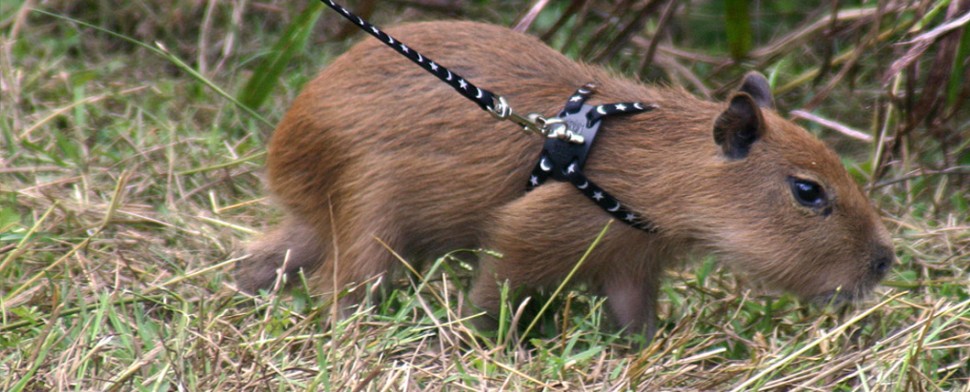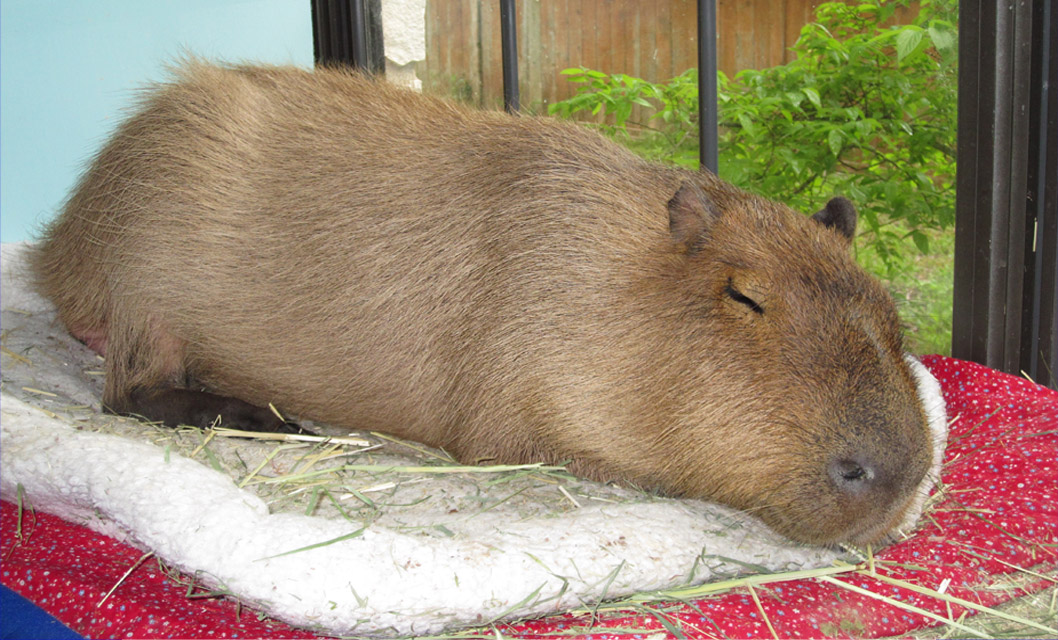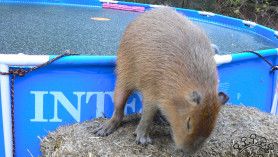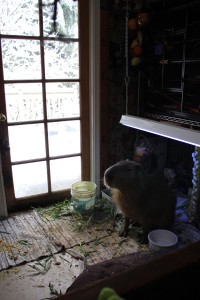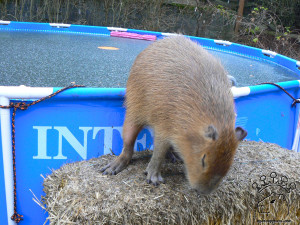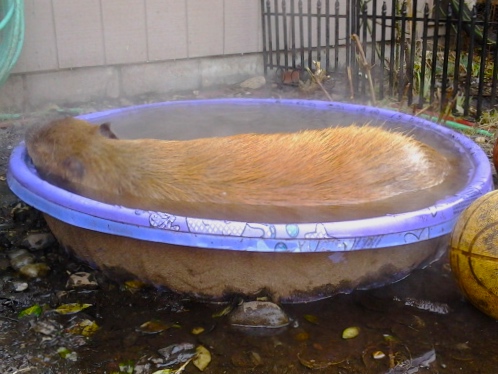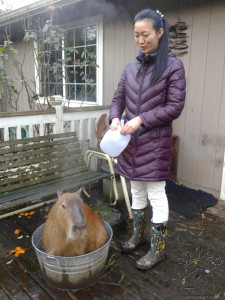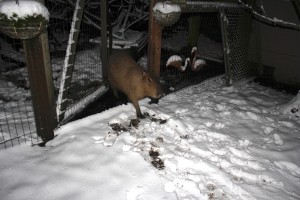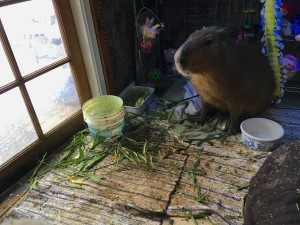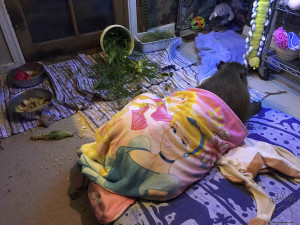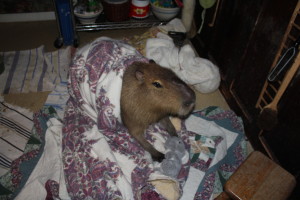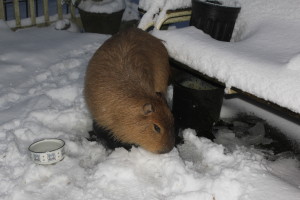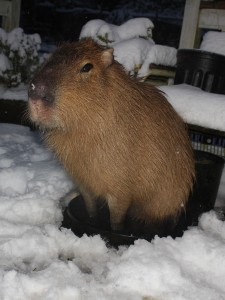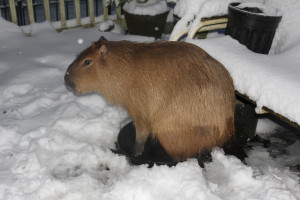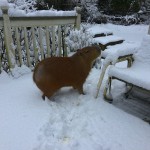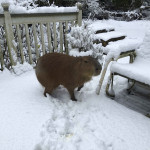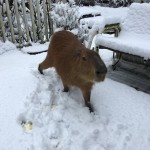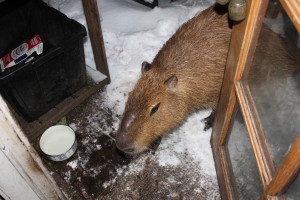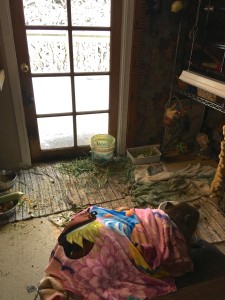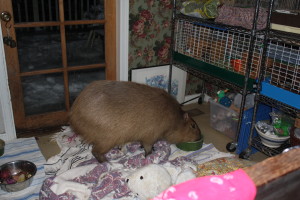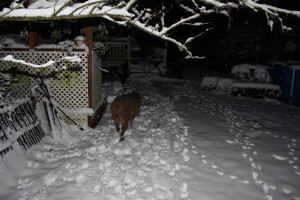Keeping pet capybaras in cold climates can be done, but it isn’t easy. Capybaras are tropical animals, so they need special accommodations, care, and precautions when housed in colder climates. This post examines some options using, as an example, my capybara, Dobby, who lived in Seattle, Washington. In it, I explain the consequences of insecure or inadequate housing.
This is Dobby’s most popular video. He is obviously annoyed with the snow, and many viewers commented about the cruelty of forcing him to live in such an inappropriate climate. That’s because they didn’t realize that he had access to the house, and his outdoor sleeping area was heated. The only reason why he ventured out into the snow for this video was that I went out there and he followed me. His annoyed clicking was probably intended for me (“Let’s go back inside!”) as much as for the snow. Still, it is worth considering your winter conditions before you get a capybara.
Winter means trouble for capybaras. Their range in South America is roughly equatorial, and even Florida has more wintry days than those tropical countries. When considering a capybara as a pet, climate is an important consideration. They seem especially prone to get frostbite. Not only do they not tolerate cold well, but they need year ’round access to swimming, or at least bathing water. I’m sure you’ve seen adorable videos of capybaras in bathtubs. Those are babies, and yes, it’s loads of fun to have them in your tub. It’s not when they hop out, shake dry, and run through the house soaking wet. It’s very cute when they are babies, but what about then they grow to 125 pounds (55 kgs)? What is your Plan B?
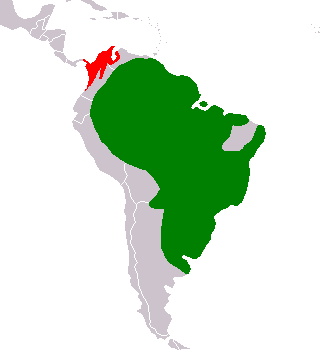
GREEN: Range of capybaras in South America (east of the Andes); RED: Range of lesser capybaras in Panama, Columbia, and Venezuela (lowlands west of the Andes)
I was quick to provide a swimming pool for Dobby’s first summer, and he loved it. Winter came too soon and poor Dobby was confused when his swimming pool froze. The ice was about 3-4″ thick, so even if he was silly enough to walk out onto it, he wouldn’t crack through the ice. Once the ice began to thaw, I fenced off these steps until the ice was completely thawed. Capybaras are good swimmers, but if they should fall through thin ice, hypothermia would set in just as it would for us. I’m not sure I could even have gotten him out of there.
If you live in an area with frequent freeze/thaw situations, it will wreak havoc on a cheap above-ground vinyl pool. Those seams can’t handle more than one season of freezing weather. A good quality pool should last, but the manufacturers probably recommend draining and winterizing those pools for good reason. If you are lucky enough to have an in-ground swimming pool, consider what changes to your maintenance schedule might be needed to accommodate a capybara. Increased filtration and sanitation would be a start. If you are going first class, heat that sucker. Dobby would dive into 50 degree water when he was a young stud, but as an older but wiser capy, he preferred water closer to 70 degrees. It’s hard to blame him.
Other options include large galvanized stock tanks. I have one that Dobby never used so I gave it to my ducks. It has rusted through in about six years. Large plastic stock tanks might be a more permanent solution. Many people use molded plastic kiddy wading pools. They are cheap, easy to dump and refill, and capybaras seem to enjoy the shallow water. Because they don’t hold much water, you can quickly make a nifty hot tub by filing it with buckets of hot water. I added a hot water faucet near the “hot tub” area to make filling super easy. Stack two to three pools at a time to make it harder for your capybara to nibble the edges (They are easier to bite than you might think.) and be sure to get a few extras: they are hard to find in winter. Sooner or later you will shatter one by breaking overnight ice out of it.
Capybaras have a thick leathery hide, but they develop rough, scaly skin (and worse) if they don’t spend enough time in water. When he was reluctant to even brave his winter hot tub, volunteers loved to pour warm water over him. The trick is to pour out the water when he’s through bathing, or you’ll find a solid chunk of ice in there the next morning.
When he was young and foolish, he would brave the weather. He would follow me while I did my chores, but we never stayed out long. Older Dobby would often decline the invitation to graze in the front yard when the ground was frozen. He would look at me and pointedly hold up his little paw, as if to say “No thanks, it’s too cold on my feet today.” He knew I would pick him a bucket of bamboo, anyway. This year, the snow is so deep, and the cold so persistent, that the bamboo hedge has completely disappeared beneath the blanket of white. In the wild, capybaras migrate to find fresh grass which can be sparse even in the Amazon basin. Be prepared to supplement winter hay with some kind of fresh forage.
- Dobby finished off a bucket of bamboo.
- One bucket of bamboo daily, to supplement hay, vegetables and fruit.
How much snow can capybaras deal with? About five minutes of snow and they’re done. They aren’t well equipped for frozen ground or slippery ice. They are designed for warm, squishy mud, not ice skating rinks. Not only that, but they are kind of “low-slung” with short legs and sagging bellies. Any kind of depth to that snow and it will be up past their belly buttons. While a dog will scamper and cavort in snow, your capybara will be ready to come indoors after the first face-plant, if not sooner.
Dobby slept indoors in the kitchen on cold nights. As a young capybara, he was nocturnally restless. I would check on him in the darkened kitchen every couple hours until about 2:00am but I always found him outdoors in the morning, trying to huddle beneath frozen blankets. The older Dobster became used to the cold weather slumber parties and eventually resigned himself to sleeping all night in the kitchen. I saved a special blanket for his slumber parties and when he saw me spread it out, he knew he was going to be sleeping indoors. It was a relief not to have to check on him every two hours. I still left the door unlatched so he could leave if he wanted to. Not that I would ever have had much luck persuading him to come back inside.
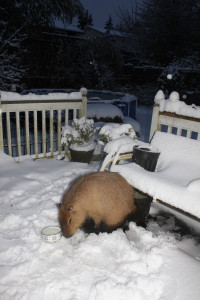
Dobby sits in a very small bowl of warm water. Note yesterday’s bowl of water, now frozen behind him, and the frozen swiming pool in the yard.
Let’s talk about frostbite. Capybaras are tropical animals, and in their native climate would never experience frozen ground. Unlike penguins or polar bears, they just aren’t equipped with biological mukluks. If we could monitor the conditions of the bottoms of their feet, we might have better luck preventing frostbite.
Though the ROUS Foundation hasn’t seen any necropsies with frostbite listed as a cause of death, anecdotally, I know of six deaths from frostbite. The first one I heard of was up in Canada. The capybara decided to push open his outside pen door one night and got frostbite and it was treated with antibiotics. The infection was persistent, though, and in spite of ongoing veterinary care, salves, soaks, bandages, and everything else they could think of, the capybara finally died of the infection in late April of that year.
The second time I heard about frostbite was in two young capybaras in that super-snowy area of upstate New York. It was a sudden, intense winter there, snow up to here, and two frisky capys. One was about a year old, the other about 8 months, and one, then the other developed frostbite. They were brought into the house, which isn’t as much fun as it sounds. Their feet became infected and they wouldn’t leave the bandaging alone even though being in the house allowed the owner to watch them carefully. The infections took them both down by spring. The owner has since moved his menagerie to Florida.
The third case involved three infant capybaras that managed to slip out the barn door. They all had frostbite on all four paws. I wish I could un-see the photo sent to me by the veterinarian. I never heard about those triplets again, but I think we know how it ended.
- Dobby steps out.
- Dobby reconsiders.
- Dobby returns.
Frostbite is deadly for capybaras because it eventually results in infection and their feet never seem to heal. The best way to prevent frostbite is to limit snow time, especially for younger animals. Capybaras tend to go walkabout. I know of several who wandered away in mild climates never to be seen again. I am aware of nine pet capybaras currently living in cold climates such as Canada. If they wander in cold weather, they can die of exposure. I heard of one who squeezed out through a gate and perished in the cold snow overnight. About half the frostbite cases have involved animals sneaking out of warm barns into the night, so secure your doors and gates in freezing weather.
Northern zoos provide heated barns for their capybaras. The Montreal capybaras live in a biodome, a tropical habitat. Years ago, a couple of Japanese zoos provided onsens (hot tubs) for their capybaras in winter. They were so popular for the capybaras and the visitors, that dozens of the zoos have them, now. Many of them also have fenced off wood stoves or other kinds of outdoor heaters for their herds to gather around. Dobby’s night pen was heated, but it wasn’t very efficient below 22f degrees (-5c) and that’s when I made him sleep indoors. If you don’t have a heated barn, and your winter temperatures dip below freezing, you ought to be thinking about which room of your house you can readily accommodate with hay, bedding, bathing, and toilet facilities for your capybara.
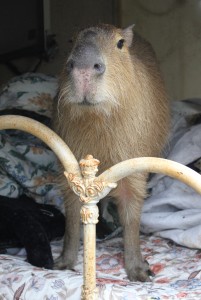
Dobby loved his cozy outdoor heated sleeping area, but he routinely slept indoors when there was snow on the ground.
If you plan to house your capybara indoors, in your house, I suggest you ask around to see how people manage this feat. I couldn’t do it because Dobby chewed everything up, and then he started “marking” the house, claiming it as his own territory. It was messier than it sounds. I gave him his own room with waist-high walls so we could always see him and talk to him, and he had a door to the yard so he could come and go as he pleased. I covered my wood floors with linoleum, and bought dozens of cheap washable rugs at IKEA. The floor was mopped every night, all the rugs washed and dried, and we were ready for the next day’s onslaught of grubbiness.
Other people have managed by cleaning constantly. Still others removed the wall-to-wall carpet and installed wood, tile or linoleum to simplify cleaning. It helps to cover the furniture with blankets or bedspreads, too. Giving them access to your home can solve the cold weather problem, but as long as it’s not freezing, they like to swim and play in mud. You’ll want to shut them out until you have a chance to hose them off.
I mentioned that Dobby marked his territory. He could also be aggressive about defending his territory, and defining his space and fencing it off meant that I didn’t have to be concerned about visitors. Even a mellow easy-going capybara like Caplin could be aggressive about his own territory, and if they have free run of the house, they can make it challenging for overnight guests. Or small children. If you live in a cold climate, it’s a good idea to plan ahead. Convincing your house-capy that it’s time to move to the barn might be met with considerable resistance.
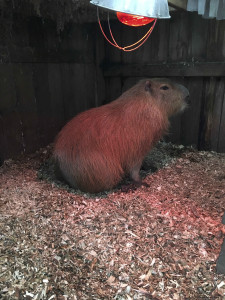
The heat lamp was there for the chickens, but I was still careful to hang it higher than Dobby’s morillo.
How about that barn? Dobby had a dry heated outdoor sleeping area with a microthermic wall heater, a heated kennel pad, and lots of blankets. I gave up on heat lamps shortly after he started to rub his morrillo on everything. I knew eventually he would rub on the bulb and either break it or burn his nose. His pen was not totally enclosed, so if it snowed, I kept him indoors. I repeat: the frostbite and exposure cases we have seen came from capybaras inexplicably squeezing past the barn door. A dry barn with safe, effective heating is your best bet in a cold climate, but you need to secure the door!
People ask us all the time about managing capybaras in cold climates, and of course, it can be done. They need to be warm, they need fresh grass and swimming, and you need to keep them out of the snow. The deep wet snow surprise we had last winter was not something Dobby would have liked. It seemed to snow forever and he would have had to spend more than two weeks, day and night, in my kitchen. He would have been miserable. He was a good sport, but it would have tried his patience, and I know he would have gone out in that snow. People who have dealt with frostbite are quick to discourage people in cold climates from getting capybaras. Weather is unpredictable, but if you are determined to get a capybara, please consider what problems your winter weather will present.



